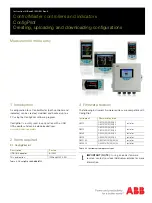
Quick Start Guide
AutoPatch DG RGBHV MTP Fiber Modules
Overview
DG (Digital Generation) RGBHV MTP
®
Fiber Transmitter (TX) and Receiver (RX)
Modules work together (FIG. 2) or in conjunction with fiber boards on an AMX
AutoPatch Distribution Matrix. This guide contains complete information for stand-
alone use. For use with a distribution matrix, see the distribution matrix’s instruction
manual on the AMX AutoPatch Software & Documentation CD or visit www.amx.com.
Product Specifications
Mounting Options
•
Desktop – attach the rubber feet (included) on the bottom of the module.
•
Rack Trays & Mounting Brackets – contact your AMX representative.
Installation
Typical System Setup
The TX receives RGBHV signals from 3 source devices and sends them over a single
high-density 12-fiber multimode cable. The RX accepts the signals from the fiber
cable, converts the signals back to RGBHV, and sends each RGBHV signal to its
corresponding destination device.
Tip: Before installing in a permanent location, place equipment close together, so the
Control PC and the Destination Monitor can be seen simultaneously during fine tuning.
To attach connectors:
1.
Check EDID switch on front of TX to be sure that it remains set to the right (WP).
2.
For each source device, insert the HD-15 connector into the RGBHV (HD-15)
jack on the rear of the TX (FIG. 3). The connector number corresponds to the
channel number. For HD-15 pinout, see FIG. 6 on reverse.
3.
For each destination device, insert the HD-15 plug into the RGBHV jack on the
rear of the RX. The connector number corresponds to the channel number.
Caution: Do not severely bend or kink the fiber cable. It can cause
irreversible damage to the cable.
4.
Insert the MTP/MPO plug on one end of the fiber cable into the Fiber (MTP/
MPO) jack on the front of the TX (FIG. 4).
5.
Insert the other end of the fiber cable into the Fiber jack on the front of the RX.
6.
Insert the power plugs into the power jacks on the TX and RX (FIG. 3).
7.
Plug the power cords into the power sources.
Important: Do not set the EDID switch to W (Write) unless directed to do so by
technical support.
To adjust resolution / refresh rate for a channel:
1.
Set the rotary switch on the front to position 9 “AutoResolution” using a small
screwdriver (see FIG. 5 for rotary switch alignment).
If fine tuning is necessary:
2.
Determine the resolution/refresh setting for the Source PC* attached to the
channel (see instructions on reverse in first column).
3.
Set rotary switch to preset number – 0, 1, or 2 – whose default settings (see
table below) correspond closest to the Source PC’s settings per Step 2.
4.
Insert USB plug from running Control PC into USB jack on the front of the TX.
Windows recognizes the new device as an HID and installs default drivers.
5.
Adjust the image using the supplied software, the RGB-Optical Wizard (see
“Video Display Adjustment” on reverse in first column).
*If source resolution is changed later, a new preset or adjustment sequence is needed.
Tip: After a resolution / refresh file has been fine-tuned using the Wizard, it can be
saved and then used for other channels connected to the same type of equipment.
Note: Default resolution / refresh files are in the <installation folder>\presets\default.
FIG. 1
Transmitter (TX) FG1010-30 Receiver (RX) FG1010-33
Specifications
Approvals
CE
Power Consumption (max.)
+12 V - +24 V DC, 13 W
Power Connector
2.1 mm DC power jack
Humidity
0 to 90% non-condensing
Operational Temperature
32° - 110° F (0° - 43° C)
Dimensions
5.22 in. (13.26 cm) depth
5.82 in. (14.78 cm) width
1.42 in. (3.61 cm) height without feet
Weight
Approximately 1.5 lbs (0.68 kg)
Compatible Fiber Modules
DG DVI MTP Fiber
Resolution Support
Up to 1920x1200 @ 60 Hz refresh rate
(with reduced sync blanking)
DDC/EDID Support
EDID resolutions provided by RGBHV TX (see reverse)
Pixel Bandwidth
1.65 Gbps
RGB Input/Output Level
700 m Vpp
HV Sync Input/Output Level
TTL compatible
RGB Input/Output Impedance
75 ohms
Fiber Cable Types
12 Fiber Multimode MTP, 50/125
µ
m or 62.5/125
µ
m
with female MTP/MPO connectors (male on module)
Fiber Cable Length
Up to 3000 ft. (914.4 m) cable requires low loss, con-
trolled skew, such as, Alcoa 50/125
µ
m Laser-Link 550
Fiber Cable Termination
Female MTP
Fiber Connector on Module
Male MTP (guide pins define it as male)
RGBHV Connector
HD-15
FIG. 2
Typical system setup (USB connection to PC for setup only)
Front
Rear
DVD
Source Devices
Destination Devices
Control
PC
TX FG1010-30
RX FG1010-33
Fiber up to 3000 ft. (914 m)
USB
FIG. 3
Attach HD-15 and power cables
FIG. 4
Attach fiber cable
FIG. 5
Adjust one channel at a time
Preset Resolution / Refresh Settings
Setting
Resolution
Refresh
0
User Configurable (default 1024x768)
60 Hz (default)
1
User Configurable (default 1280x1024)
60 Hz (default)
2
User Configurable (default 1600x1200)
60 Hz (default)
3
640x480 (cannot be tuned with software)
60 Hz
4
800x600 (cannot be tuned with software)
60 Hz
5
1024x768 (cannot be tuned with software)
60 Hz
6
1280x1024 (cannot be tuned with software)
60 Hz
7
1600x1200 (cannot be tuned with software)
60 Hz
8
Reserved
9
AutoResolution (scans settings 3 through 7)
HD-15 Cable
Power Cable
Power
Indicator
USB connection
for wizard option
EDID switch remains
Rotary Switch
Default 0
AutoResolution 9
so source & destination
can share information
(Step 4 below)
Preset resolution/refresh settings (Step 1 above)
set to WP (Write-Protect),
Fiber Cable




















